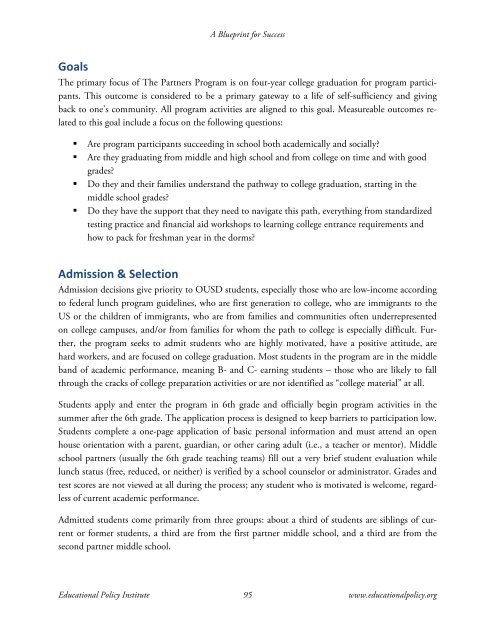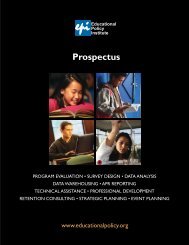A BluePrint for Success: Case Studies of Successful - Educational ...
A BluePrint for Success: Case Studies of Successful - Educational ...
A BluePrint for Success: Case Studies of Successful - Educational ...
Create successful ePaper yourself
Turn your PDF publications into a flip-book with our unique Google optimized e-Paper software.
Goals<br />
A Blueprint <strong>for</strong> <strong>Success</strong><br />
The primary focus <strong>of</strong> The Partners Program is on four-year college graduation <strong>for</strong> program participants.<br />
This outcome is considered to be a primary gateway to a life <strong>of</strong> self-sufficiency and giving<br />
back to one’s community. All program activities are aligned to this goal. Measureable outcomes related<br />
to this goal include a focus on the following questions:<br />
Are program participants succeeding in school both academically and socially?<br />
Are they graduating from middle and high school and from college on time and with good<br />
grades?<br />
Do they and their families understand the pathway to college graduation, starting in the<br />
middle school grades?<br />
Do they have the support that they need to navigate this path, everything from standardized<br />
testing practice and financial aid workshops to learning college entrance requirements and<br />
how to pack <strong>for</strong> freshman year in the dorms?<br />
Admission & Selection<br />
Admission decisions give priority to OUSD students, especially those who are low-income according<br />
to federal lunch program guidelines, who are first generation to college, who are immigrants to the<br />
US or the children <strong>of</strong> immigrants, who are from families and communities <strong>of</strong>ten underrepresented<br />
on college campuses, and/or from families <strong>for</strong> whom the path to college is especially difficult. Further,<br />
the program seeks to admit students who are highly motivated, have a positive attitude, are<br />
hard workers, and are focused on college graduation. Most students in the program are in the middle<br />
band <strong>of</strong> academic per<strong>for</strong>mance, meaning B- and C- earning students – those who are likely to fall<br />
through the cracks <strong>of</strong> college preparation activities or are not identified as “college material” at all.<br />
Students apply and enter the program in 6th grade and <strong>of</strong>ficially begin program activities in the<br />
summer after the 6th grade. The application process is designed to keep barriers to participation low.<br />
Students complete a one-page application <strong>of</strong> basic personal in<strong>for</strong>mation and must attend an open<br />
house orientation with a parent, guardian, or other caring adult (i.e., a teacher or mentor). Middle<br />
school partners (usually the 6th grade teaching teams) fill out a very brief student evaluation while<br />
lunch status (free, reduced, or neither) is verified by a school counselor or administrator. Grades and<br />
test scores are not viewed at all during the process; any student who is motivated is welcome, regardless<br />
<strong>of</strong> current academic per<strong>for</strong>mance.<br />
Admitted students come primarily from three groups: about a third <strong>of</strong> students are siblings <strong>of</strong> current<br />
or <strong>for</strong>mer students, a third are from the first partner middle school, and a third are from the<br />
second partner middle school.<br />
<strong>Educational</strong> Policy Institute 95 www.educationalpolicy.org




